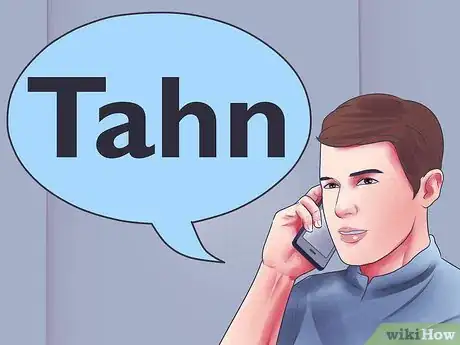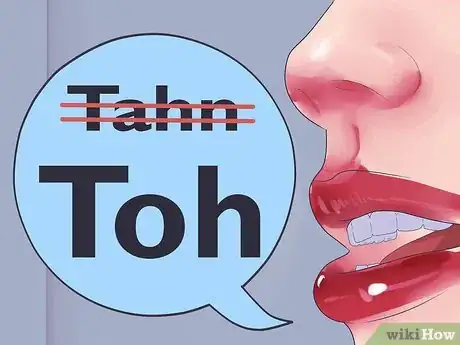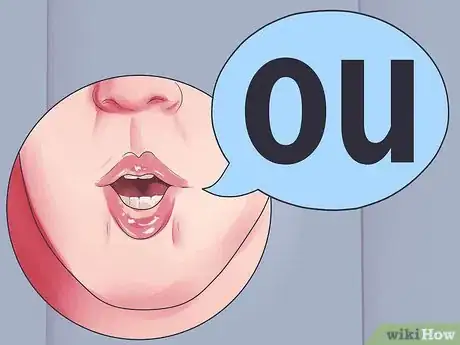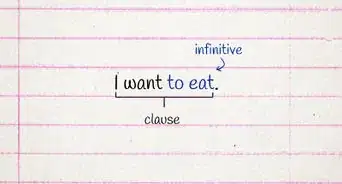wikiHow is a “wiki,” similar to Wikipedia, which means that many of our articles are co-written by multiple authors. To create this article, 15 people, some anonymous, worked to edit and improve it over time.
This article has been viewed 190,983 times.
Learn more...
Whether you're trying to figure out how to pronounce "Louis Vuitton" in English, say it with a high-class French accent, or even pronounce the name of the actual model of bag you've purchased, all you need are a few basic instructions (and a little practice) to sound tres chic.[1]
Steps
Using an English Pronunciation
-
1Say “Louie.” If you're going for the basic English pronunciation of "Louis Vuitton", the first word is a piece of cake. All you need to do is say the male English name "Louie" (as in Louis C.K., Louis Armstrong, Louis XIV, and so on). That's it! No extra work required.[2]
- Trivia: The Louis Vuitton brand is named after its founder, Louis Vuitton, a French craftsman and businessman who started the company in the 1850s. That's why the first word in the company's name can be pronounced like the name "Louie" — it is that name.
-
2Say “Vit.” The second word, "Vuitton" looks a little more intimidating, but it's not actually very hard to pronounce in English. The first syllable should be pronounced "vit" (rhymes with "fit"). Ignore the U — in English, it's more or less silent.
- You can also use a softer "voot" sound (rhymes with "foot"; not "boot") if you prefer.
Advertisement -
3Say “Tahn.” Next, to finish "Vuitton", make a "tahn" (rhymes with "brawn") sound for the second syllable. Put the the stress in the word on this syllable — it's "vit-TAHN", not "VIT-tahn".[3]
- In English, stressing the second syllable of a two-syllable word is usually used for verbs, not nouns.[4] However, in this case, most native speakers don't find this confusing — perhaps because the word has a foreign origin.
-
4Put it all together! You've got everything you need to say "Louis Vuitton" now! Give it a few tries: "Loo-ee Vit-ahn." Practice makes perfect, so don't be afraid to start saying it out loud, even if others are around.[5]
-
5Optionally, end with the French “Toh”. Some English speakers who like to sound fancy or high-class when they're talking about the bag they just bought throw in just a little French pronunciation at the very end of the typical English version of "Louis Vuitton." To do this, instead of ending with the normal "tahn" sound, try "toh" (almost rhymes with "thaw"). This isn't quite how the French say it, but for the average English speaker, it's a good compromise compared to trying to work out tricky French vowels.
- For extra points, try to push just a little air out of your nose when you end the word. If you do it right, you'll sound just a little stuck-up — the perfect compliment to that "just bought a new bag" feeling.
Using a French Pronunciation
-
1Say “Lwee.” Saying "Louis Vuitton" with its real French pronunciation is a little trickier than saying it in its English form. First, let's tackle "Louis." The pronunciation here is similar to the way it is in English, but not identical. In French, "Louis" is said very quickly (almost as a single syllable). The result is that the "lou" sound at the start of the word becomes very short. For an English speaker, it's easiest to approximate this by simply shortening the word to "lwee."
-
2Say “Vwee.” Unlike in English, the U in "Vuitton" isn't silent in French. Give it a light W sound. Don't "dig in" with the W sound — try to keep your lips from pursing too closely In English, Ws almost never follow Vs, so this syllable can be a little counter-intuitive, but be patient and you should get it before long.[6]
- The I in Vuitton should have the same sound as the long E vowel sound in "squeeze." However, it should be very quick, so if it ends up sounding a little like the I sound in "thin", it's OK.
-
3Say “Toh.” In French, the "-on" ending, with very few exceptions, has a silent "N" sound. This means that you basically only need to make an ordinary "O" sound (like in "low" or "so"). However, to sound truly French, you'll want to "nasalize" this vowel by pronouncing it partly with your nose. Try to keep your lips from pursing as they would in English when making the "O" sound. Instead, keep your mouth open slightly and your tongue in the middle of your mouth.[7]
- Try this easy test to see if you're saying "toh" correctly: put your finger just under your nose as if you're about to sneeze, then try saying the syllable. You should feel a tiny puff of air from your nose — this and many other French words use nasal sounds as part of their normal pronunciation.
-
4Put it all together! You're all ready to say "Louis Vuitton" like a native speaker. Follow all the rules above as you combine the syllables you've been practicing into one coherent whole. Your pronunciation of "Louis Vuitton" should sound a little like "Lwee VwitOH." Practice makes perfect, so don't be afraid to try saying it a few times on your own before you start saying it in public![8]
- If you're having trouble, try listening to a French speaker say the words. If you don't know any, just use your preferred search engine to run a quick search for "Louis Vuitton French Pronunciation" — you should easily find at least a few helpful video guides.
-
5For perfect pronunciation, use a French “ou” sound. The instructions above will have you saying "Louis Vuitton" with a close approximation of an actual French accent, but they're not quite perfect. In French, the "ou" vowel combination can actually sometimes result in a sound that isn't used in English. For your pronunciation of "Louis Vuitton" to be perfect, you'll want to practice this vowel sound and use it in "Louis" in place of the English "oo" sound you may have been making before.
- To practice this new "ou" sound, start out by saying the English "O" sound as in "glow" or "snow". Purse your lips close together — you're trying to look like you're drinking out of an invisible straw. Finally, without moving your mouth, start saying the English "E" sound as in "free" or "glee". The sound that comes out of your mouth should be a combination of "O" and "E" that sounds odd to English-speaking ears. This is the sound you'll want to use for "Louis!"
Pronouncing Louis Vuitton Products
-
1Pronounce Damier "dah-myay." Once you've mastered the name of the label itself, try teaching yourself how to pronounce some of the tongue-twisting French names of its products. For starters, try pronouncing "Damier." The first syllable is easy: "dahm" rhymes with "bomb." The second is a little trickier: "myay" rhymes with "play." Don't forget to sound out the I in the word — it's "DahMYAY," not "DahMAY."[9]
- Keep in mind that, in French, the "-ier" ending almost always has a silent R sound.
-
2Pronounce Multicolor "mooltee-colohr." To pronounce this bag's name, you have to use long vowel sounds for every vowel you encounter. The first syllable, "mool", rhymes with "pool". The next, "tee", is pronounced how it sounds. The third syllable, "col", sounds like "coal." Finally, the ending syllable sounds like "lore", only with a light, delicate R sound made by pressing the back of your tongue against the top of your mouth.
- Don't forget that, in French, I usually has an "ee" sound (not an "eye" sound). Thus, you would never say "mult-EYEcolor."
-
3Pronounce Tahitiennes "tah-ee-tee-enneh." The tricky part of pronouncing "Tahitiennes" is ignoring the way it's spelled, which can cause problems for English speakers. Simply sound out the first three syllables, "tah," "ee," and "tee". The last two are a little trickier — they're pronounced "enn-uh", with no S sound, even thought there's an S at the end of the word. Don't forget the final "eh" or "uh" syllable. It should be delicate, but audible.
- Note that the French H sound here is very light or silent. The word doesn't have an audible "hee" sound as in the English "Tahitian."
-
4Pronounce Popincourt "pope-in-cohre." It can be tempting to pronounce this word "Poppin Court," but resist it! Instead, say "pope," then "in", then "cohre" (rhymes with "bore"). Use the same light, delicate R sound as in "Damier" to end the word, rather than a hard English R.
- Don't pronounce the T at the end of the word — once again, the final consonant is silent here.
-
5Pronounce Batignolles "bat-een-yoleh." In French, the "gn" consonant pair makes a "nyuh" sound like the n in "habañero." With that in mind, pronounce "Batignolles" by sounding out the syllables "bat", "een" (rhymes with "mean"), "yol" (rhymes with "role"), and "eh". As with Tahitiennes, the final S is silent, but there is still a very light fourth "eh" syllable.[10]
References
- ↑ https://www.bbc.com/news/magazine-11372095
- ↑ https://www.youtube.com/watch?v=k8tn9MZtoZY
- ↑ https://www.youtube.com/watch?v=k8tn9MZtoZY
- ↑ https://www.englishclub.com/pronunciation/word-stress-rules.htm
- ↑ https://www.youtube.com/watch?v=k8tn9MZtoZY
- ↑ https://www.youtube.com/watch?v=k0VoAYJCnEg
- ↑ https://www.youtube.com/watch?v=k0VoAYJCnEg
- ↑ https://www.youtube.com/watch?v=k8tn9MZtoZY
- ↑ https://youtu.be/ZQFecGuGa6Y?t=30
About This Article
For the english pronunciation of Louis Vuitton begin by saying the name Louie, as in Louis Armstrong. To pronounce “Vouitton” first say “vit”, rhymes with “fit”, and follow that by saying “tahn”, which rhymes with “brawn.” For the french pronunciation Louis is pronounced as "lwee" kind of like a one syllable version of "Louie." For “Vouitton” begin by saying "vwee" and try to keep your lips from pursing to closely. In french the ‘n’ is typically silent, so for the second half of “Vouitton” pronounce it "toh." For tips on pronouncing Louis Vuitton products, scroll down!









































































